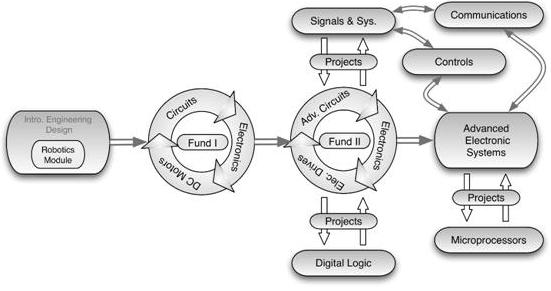What is spiral curriculum?
Spiral curriculum, a concept widely attributed to Jerome Bruner [1], refers to a curriculum design in which key concepts are presented repeatedly throughout the curriculum, but with deepening layers of complexity, or in different applications. Such treatment allows the earlier introduction of concepts traditionally reserved for later, more specialized courses in the curriculum, after students have mastered some fundamental principles that are often very theoretical and likely to discourage students who are eager to apply the concepts they are learning to real-world applications.
How does this method help the student?
Over the past several years, Detroit Mercy’s Electrical & Computer Engineering (ECE) program has designed and implemented such a spiral curriculum, built on a robotics theme. In their very first semester at the university, all engineering students complete a hands robotics project that introduces concepts related to mechatronics. As the ECE students progress through the integrated curriculum, they complete more complex robotics projects, and participate in courses that are tightly integrated with each other.
How it works

Figure X: Electrical Engineering Spiral Curriculum
Figure X represents the spiral structure of the curriculum, showing how traditionally disparate topical areas are treated in an integrated fashion in the two fundamentals courses (Fund I and Fund II). After Fund I, the students begin to experience tight integration across courses. For example, shared projects across Fund II, Signals and Systems, and Digital Logic have been a consistent feature in the four years since the curriculum was launched. Signals and Systems introduces concepts related to control and communications systems which are later reinforced in two separate courses. The Advanced Electronic Systems course continues the integration with shared projects with the Microprocessors course. All of this prepares students to think of EE design as a systems integration problem rather than simply a collection of unrelated component designs that are never put together in a larger context.
[1] J. S. Bruner, The process of education. Cambridge, MA: Harvard University Press, 1960.
